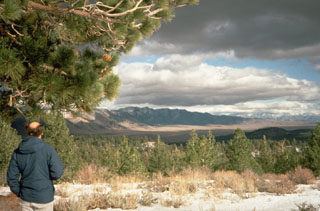Report on Long Valley (United States) — November 1983
Scientific Event Alert Network Bulletin, vol. 8, no. 11 (November 1983)
Managing Editor: Lindsay McClelland.
Long Valley (United States) Brief earthquake swarm in S part of the caldera
Please cite this report as:
Global Volcanism Program, 1983. Report on Long Valley (United States) (McClelland, L., ed.). Scientific Event Alert Network Bulletin, 8:11. Smithsonian Institution. https://doi.org/10.5479/si.GVP.SEAN198311-323822
Long Valley
United States
37.7°N, 118.87°W; summit elev. 3390 m
All times are local (unless otherwise noted)
A small earthquake swarm occurred in the S part of the caldera on 14 November. Between the start of the swarm at 1909 and its end about 40 minutes later, 40-50 events larger than M 0.8 were detected. The strongest shocks had magnitudes of 3.2 (at 1929) and 3.0 (at 1936). The 14 November events (centered about 6.5 km SE of the town of Mammoth Lakes) were within the epicentral zone of the major January swarm (SEAN 07:12 and 08:01), but about 3 km SE of the initial January swarm seismicity. Focal depths of the November earthquakes ranged from 2.5-4 km, making it the first swarm for which it was possible to confirm that no events were deeper than 4 km; depths of past swarms were typically 3-7 km. Some seismicity continued after the end of the main swarm at 1950; all events during the next 4 hours were at depths of 2-3.5 km.
Roughly 8 km to the W (under the E flank of Mammoth Mountain) a swarm of about 50 events had occurred 24 September between 0525 and 0630. The largest magnitude was 2.8. Seismic stations were too distant for precise depth determinations, but the events were roughly between 4 and 6.5 km depth. A slight increase in seismicity was noted in the same area at the end of November.
Geological Summary. The large 17 x 32 km Long Valley caldera east of the central Sierra Nevada Range formed as a result of the voluminous Bishop Tuff eruption about 760,000 years ago. Resurgent doming in the central part of the caldera occurred shortly afterwards, followed by rhyolitic eruptions from the caldera moat and the eruption of rhyodacite from outer ring fracture vents, ending about 50,000 years ago. During early resurgent doming the caldera was filled with a large lake that left strandlines on the caldera walls and the resurgent dome island; the lake eventually drained through the Owens River Gorge. The caldera remains thermally active, with many hot springs and fumaroles, and has had significant deformation, seismicity, and other unrest in recent years. The late-Pleistocene to Holocene Inyo Craters cut the NW topographic rim of the caldera, and along with Mammoth Mountain on the SW topographic rim, are west of the structural caldera and are chemically and tectonically distinct from the Long Valley magmatic system.
Information Contacts: R. Cockerham, USGS, Menlo Park, CA.

